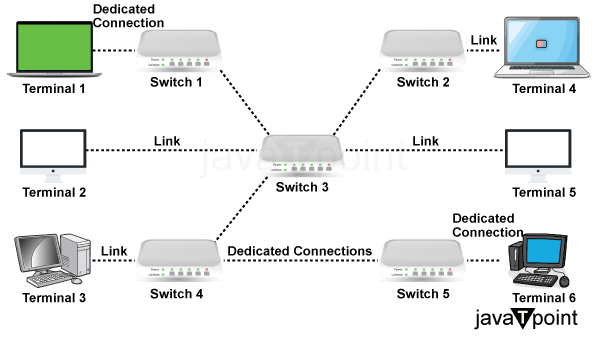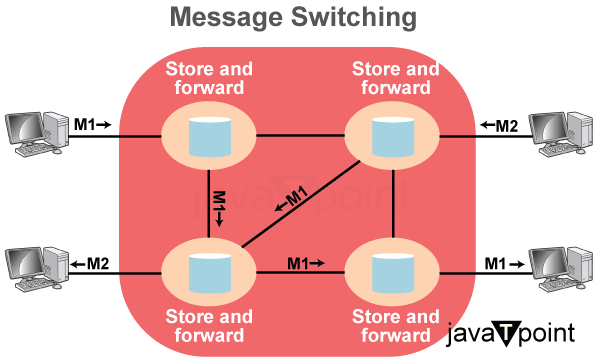Differentiate between Circuit Switching, Message Switching, and Packet SwitchingIntroductionSwitched communication networks route data between a number of intermediate nodes as it travels from source to destination. Nodes accomplish data transmission between certain locations on a network via a mechanism called switching. The three typical switching methods are as follows:
In this topic, we will discuss the three types of switching methods and also differentiate between them. Types of Switching Methods1. Circuit SwitchingWhen constructing a telecommunications network circuit, switching is a technique in which two network nodes first establish a specialized communications channel (circuit) within the network before corresponding with one another. The circuit assures the channel's full bandwidth and maintains connectivity throughout the communication session. The circuit acts as though the nodes were physically connected, exactly like an electrical circuit. When a dedicated circuit was formed between two phones for the duration of a call by the network in analog telephone networks, circuit switching was first employed. In contrast, trunklines between switching centers in message switching and packet switching systems used in modern digital networks transport data between several nodes in the form of data packets without the use of dedicated circuits. A circuit-switched network's basic example is the early analog telephone network. The telephone exchange switches establish a continuous wire circuit between the two phones whenever a call is placed from one phone to the other, lasting throughout the call. 
As contrasted to packet switching, where packet queues may result in variable and potentially endlessly long packet transfer delays, the bit delay in circuit switching remains constant throughout a connection. No circuit can be compromised by competing users since it is shielded from use until the circuit is released and a fresh connection is established. The channel is still restricted and shielded from rival users, even if no communication is actually happening. Although circuit switching is typically used to connect voice circuits, the concept of a dedicated conduit being constant between two communication parties or nodes can be expanded to communicate material other than voice. The benefit of employing circuit switching is that it offers continuous transfers without the overhead associated with packets, maximizing the utilization of available bandwidth for that connection. Its potential for being relatively inefficient comes from the fact that other connections on the same network cannot utilize unused capacity pledged to a connection. Furthermore, if the circuit is disrupted, calls are not possible and will be dropped. 2. Message SwitchingBefore packet switching was discovered, a method called message switching was created as a complement to circuit switching. By communicating through messages that contain the entire amount of information to be transmitted, end users converse through message switching. A message is the most basic form of a unit. 
The sender and receiver do not have a direct connection. Many intermediate nodes are involved in data transport and making sure the message gets to its designated location. Thus, message-switched data networks are sometimes known as hop-by-hop systems. They offer two separate and significant qualities:
Characteristics of Message Switching The benefit of message switching is that it makes it possible to use network resources effectively. Additionally, traffic may be easily regulated and monitored because of the store-and-forward functionality of intermediary nodes. Another advantage is the delivery of messages as a whole rather than in pieces. Message switching, however, also has certain drawbacks. Switches need a lot of storage space since messages are perpetually held at each intermediate node. They move very slowly as well. This is due to the fact that each node must wait until it has received the complete message before processing the next node and any linkages to it, which depends on channel traffic and availability. The use of message switching in real-time or interactive applications, such as video conferences, is therefore not possible. 3. Packet SwitchingSmall bits of data are moved between networks through a process called packet switching. These data "chunks" or "packets" allow for quicker, more efficient data transmission. Normally, when a user transmits a file across a network, it is sent in fewer data packets rather than all at once. As an illustration, a 3MB file will be separated into packets, with the header of each packet providing the sequence number, the origin IP address, the destination IP address, the number of packets in the full data file, and the number of packets in the file. 
The two main categories of packet switching are: 1. Connection-less packet switching: Each packet in this traditional form of packet switching is routed separately. As a result, each packet has complete routing information. The shifting loads on the network's nodes (adapters, switches, and routers) also make it possible for different transmission techniques and out-of-order delivery. Datagram switching is another name for this form of packet switching. In connectionless packet switching, the header section of each packet contains the following data:
Sequence number (Seq#) for reassembly The receiving devices rearrange the packets once they have arrived at their destination via numerous paths to create the original message. 2. Connection-Oriented Packet Switching: The data packets are assembled before being numbered in connection-oriented packet switching. It is also known as virtual circuit switching or circuit switching. They then go consecutively along a predetermined route. Since all packets are sent in order while using circuit switching, address information is not required. Difference between Circuit Switching, Message Switching, and Packet Switching
ConclusionIn conclusion, the paradigms of circuit switching, message switching, and packet switching each offer a unique approach to data transmission. Circuit switching, which is best demonstrated by conventional telephone networks, offers a dedicated and dependable connection for the duration of a session, making it appropriate for real-time voice communication. Despite being flexible in managing messages of varying lengths, message switching can be less effective because it requires storing and forwarding whole messages. On the other side, packet switching, the foundation of contemporary data networks like the internet, excels at effectively utilizing bandwidth, handling a variety of data formats, and facilitating real-time and bursty data transfer. As technology advances, packet switching has become the dominant and adaptable technique for fulfilling the needs of modern communication networks, enabling the frictionless interchange of information across the globe. Due to its adaptability to different data formats and effective use of network resources, packet switching has significantly favored the expansion of communication networks.
Next TopicWhat is Web 3.0
|
 For Videos Join Our Youtube Channel: Join Now
For Videos Join Our Youtube Channel: Join Now
Feedback
- Send your Feedback to [email protected]
Help Others, Please Share










